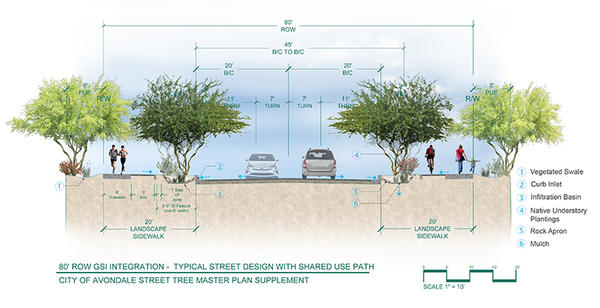 Arizona cities are increasingly looking to incorporate green stormwater infrastructure (GSI) into their roadway designs to boost urban forestry and complete streets goals while conserving municipal water supplies. WMG has been on the cutting edge of this evolution as – for the last decade – we’ve worked with municipalities statewide to break down barriers in implementing GSI. We’ve done this by providing practical designs and policies, partnering on demonstration projects, and helping address maintenance needs. One of our latest GSI clients is the City of Avondale in the Phoenix Valley.
Arizona cities are increasingly looking to incorporate green stormwater infrastructure (GSI) into their roadway designs to boost urban forestry and complete streets goals while conserving municipal water supplies. WMG has been on the cutting edge of this evolution as – for the last decade – we’ve worked with municipalities statewide to break down barriers in implementing GSI. We’ve done this by providing practical designs and policies, partnering on demonstration projects, and helping address maintenance needs. One of our latest GSI clients is the City of Avondale in the Phoenix Valley.
Avondale had experimented with green stormwater infrastructure on a Complete Streets project along its Central Avenue and reached out to WMG to improve their GSI design and learn best maintenance practices.
WMG’s Policy and Technical Director Catlow Shipek and Project Designer Nichole Casebeer worked with the city to incorporate green infrastructure as a policy supplement to Avondale’s existing Street Tree Master Plan. Through the development of the policy supplement, city staff emphasized the importance of designing for maintenance, ensuring longterm tree health through appropriate species selection and placement, maximizing water conservation, enhancing community bike and pedestrian mobility, and promoting a sense of place at the foot of the Estrella Mountains and along the Agua Fria and Salt Rivers.
The resulting policy supplement includes roadway design standards for both collector and arterial streets that integrates stormwater harvesting basins to support shade trees and understory vegetation. Even in a desert city with just eight inches of annual rainfall, WMG’s designs were able to meet the majority of plant irrigation needs!
WMG developed standard roadway designs that incorporated both green infrastructure and a shared multi-use separated path that achieved the following high performance goals:
-
Stormwater basins collect, retain, and infiltrate the first one inch of rainfall on both arterial and collector streets.
-
Infiltrated stormwater along the roadway provides 100% of the irrigation demand once plants are established. The center median along arterial streets will require supplemental irrigation to meet city planting standards due to the minimal catchment area associated.
-
20% and 25% tree canopy coverage for arterial and collector streets respectively.
-
25% understory plant coverage for the landscaped areas and basins.
-
To foster a sense of place, a requirement that at least 75% of the total number of plants will be native.
WMG’s work is already paying off! Avondale’s Environmental and Sustainability Program Manager Hether Krause, who is also involved with the Sustainable Cities Network for the greater Phoenix Valley, told us that she has “already shared the street designs with a recently proposed development and they will integrate green infrastructure into a proposed park and surrounding roadways.” Ms. Krause is excited to work towards a formal adoption of the policy supplement in a future revision to Avondale’s Street Tree Master Plan.
To see the full report, as well as WMG’s "Green Infrastructure for Desert Communities" manual, visit Watershedmg.org/GSI.





